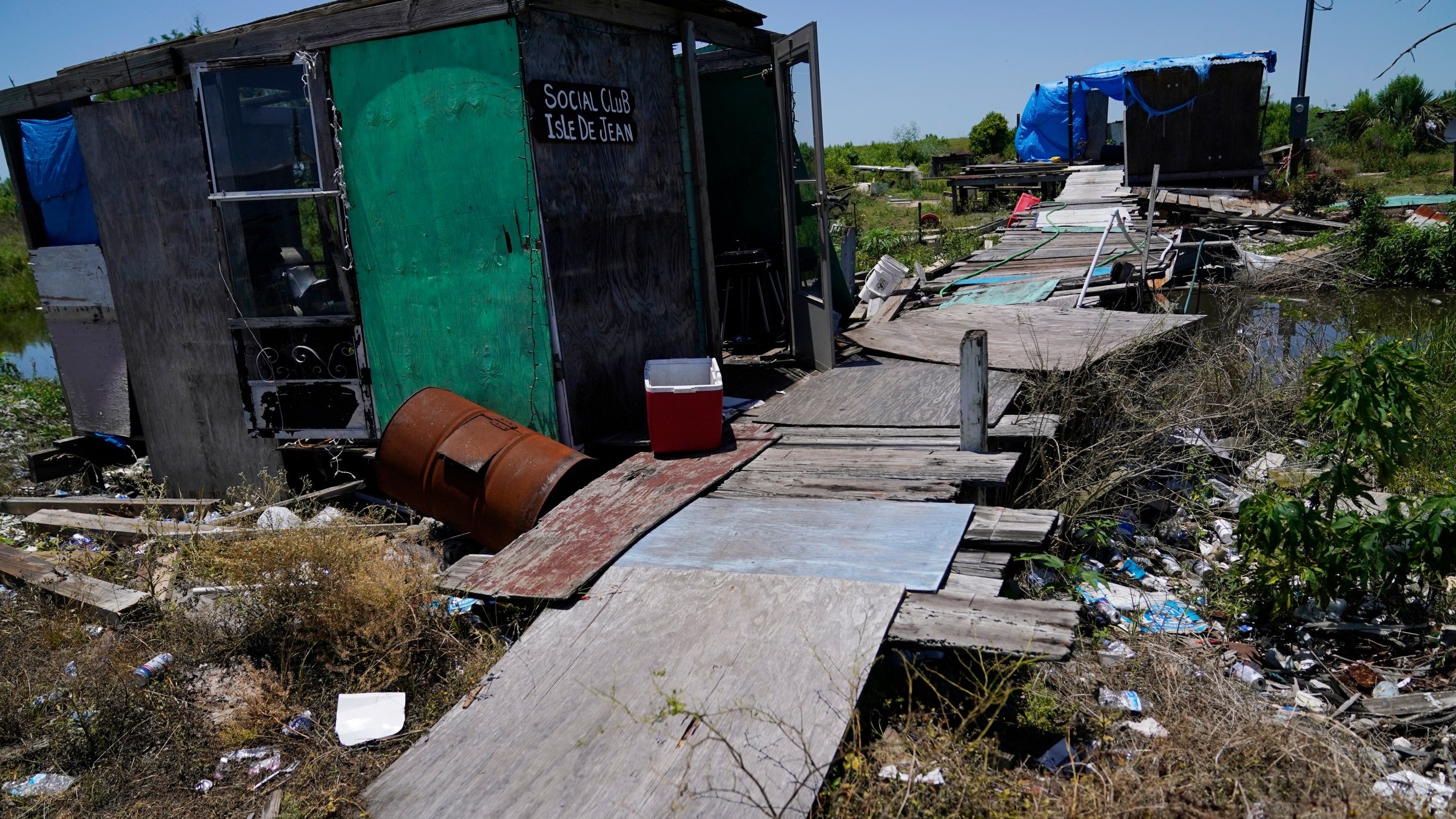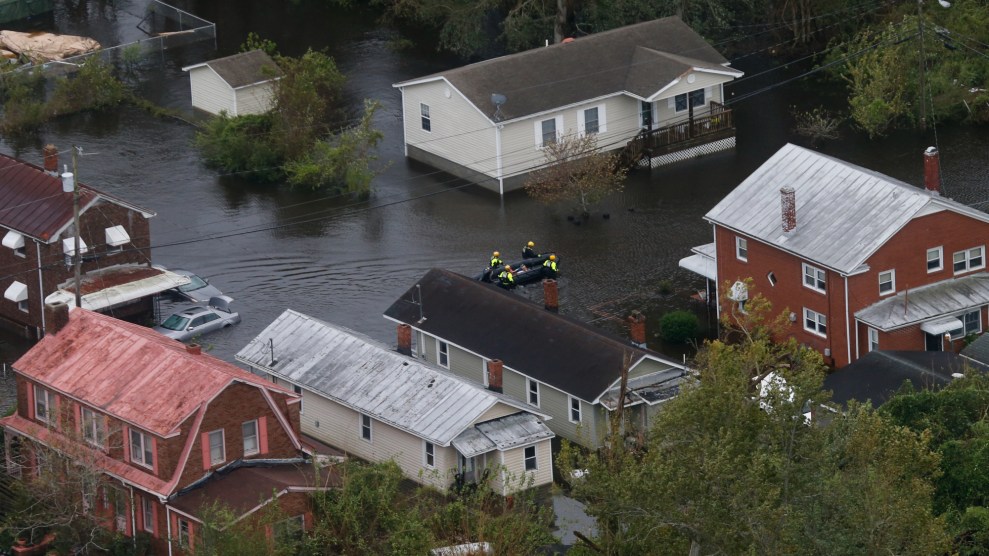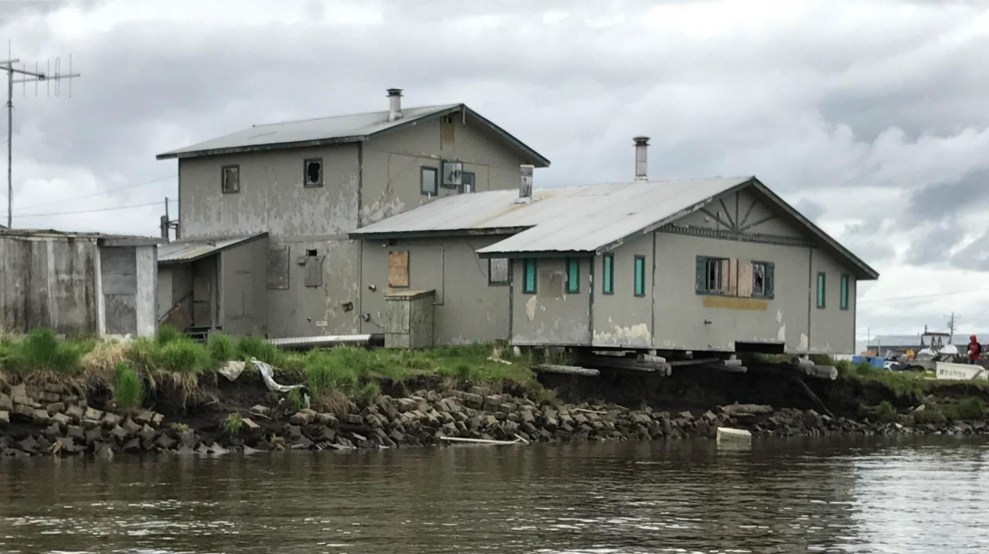This article was produced in partnership with Columbia Journalism Investigations, the Center for Public Integrity and Type Investigations.
Isle De Jean Charles, Louisiana—A sliver is all of this islet that remains above water. What hasn’t slipped into the Gulf of Mexico shows the punishing effects of disastrous climate change: trees killed by saltwater, grasslands overtaken by bayous, empty wrecks that were once homes.
“Our house was here,” said Albert White Buffalo Naquin, pointing to the overrun marsh where his family lived. He is chief of the Jean Charles Choctaw Nation, and 98% of its ancestral land is below water.
The US Department of Housing and Urban Development awarded the state $48.3 million in 2016 to resettle the tribe to higher ground, the first federally funded effort to move an entire community because of climate change. Officials saw a chance to create a model of wholesale voluntary relocation for a country that urgently needs to prepare for many more such projects.
Six years in, Isle de Jean Charles underscores how challenging this work will be—and how badly the country will fail the ever-growing number of people in harm’s way if it doesn’t figure out how to do it well.
Tribal leaders contend that the process disenfranchised them. As the process of moving families to the new site gets underway, Naquin and his tribal council are working on a different resettlement and reunification plan—this time, without government help.
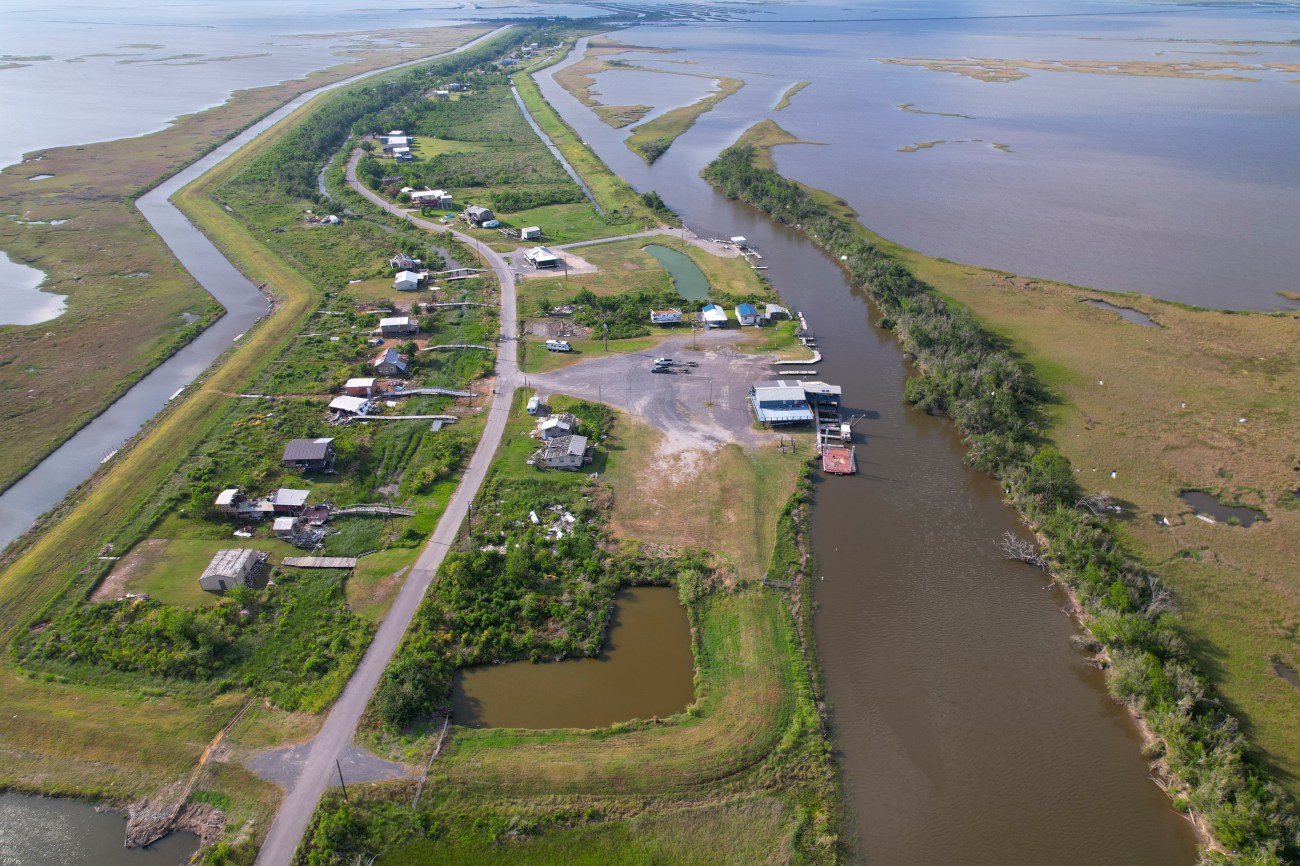
Isle de Jean Charles, Louisiana, in May 2022.
Olga Loginova / Columbia Journalism Investigations
Early missteps undermined trust and shifted who was eligible to participate, according to a year-long investigation by Columbia Journalism Investigations, the Center for Public Integrity and Type Investigations. The news organizations conducted interviews with dozens of tribal leaders, island residents, researchers, and former and current government officials, and reviewed more than 2,000 government and tribal records.
The way the funding was structured prevented the Jean Charles tribe from applying on its own. Instead, members had to work with a state agency, the Office of Community Development, which Naquin, other members of the tribal council, and several academics observing the process say failed to implement the tribe’s vision of resettling from the crumbling island and bringing back the citizens dispersed by past disasters.
Records show that agency officials, in turn, relied on a nonprofit group working with the tribe for information about island residents—and they were caught off-guard to learn, after winning the grant, that additional people needed relocation.
Citizens of the United Houma Nation also live on the vanishing isle. When that tribe’s then-chief learned of the funding, he pressed the state to include his people, too.
After that, the plan changed. Rather than move to the new location all interested members of the Jean Charles tribe, including those driven out decades earlier by disasters and land loss, state officials said only those who live on the island, left after a 2012 hurricane or moved earlier to a place hit by that same disaster would be eligible.
For Naquin— among those locked out by the change—this meant his tribe would not be reunified after all. In 2018, after numerous unsuccessful attempts to bring the project back to its original vision, he urged HUD to revoke the money. The agency didn’t do so. Fair-housing law, HUD said, required that everyone on the island be provided the opportunity to move.
Relocation experts warn that climate resettlement in the US will fall far short without major changes to the federal government’s approach. They said Isle de Jean Charles illustrates the need for an organized effort—a designated federal agency focused on community resettlements—with far more money, fewer bureaucratic hurdles, and greater sensitivity to the needs of communities impacted by the United States’ long history of forced relocation and racism. Those are often the places most threatened by the climate crisis.
That’s particularly true for the hundreds of tribes without federal recognition, largely cut off from federal grants.
A.R. Siders, a climate adaptation researcher at the University of Delaware’s Disaster Research Center, said historically marginalized communities shouldn’t have to compete against each other for the right to be saved. But that’s exactly what is happening. An Alaska Native village endangered by flooding and erosion had also vied for the funding ultimately earmarked for Isle de Jean Charles. And once the money arrived, it pitted the two tribes on the island against each other.
“We really could increase the amount of funding going to these kinds of relocation so that it doesn’t have to be such an either-or choice in the future,” Siders said.
There’s little time to waste. Already, communities hard hit by rising seas and intensifying hurricanes, floods, and wildfires are finding that the country offers little organized assistance for relocating people together, according to an investigation by Columbia Journalism Investigations and its partners. Those seeking help from a patchwork of programs face steep barriers— particularly in communities of color.
The mismatch between need and assistance will get worse if nothing is done. Federal research predicts that more than 13 million Americans may have to move away from vanishing shorelines up and down the coasts over the rest of the century, a figure that doesn’t include the impact of other climate disasters.
HUD did not respond to requests for comment.
Pat Forbes, who heads the Louisiana Office of Community Development, was involved in the Isle de Jean Charles project from the start. Forbes acknowledged that it has faced challenges but defended the outcome. Over the next few months, he said, the agency will give out keys to new homes for 37 eligible households on The New Isle, the state’s resettlement site 40 miles from Isle de Jean Charles. Some former island residents living in areas hit by 2012’s Hurricane Isaac will get the rights to build on empty lots there.
Had the state known the island demographics earlier, Forbes insists, the end result would have been the same. “We still would have turned in an application that represented an opportunity for folks living on the island, irrespective of tribal association, to move to a safer place and to try to keep that cohesive culture together.”
The latest concern is that the property taxes and insurance costs could prove impossibly high for many movers with no resources beyond Social Security payments. Forbes said his agency is trying to find a solution to cover insurance costs, but the annual property taxes—between $735 and about $1,220, depending on the size of the house—would have to be paid by the new owners.
Community relocation is a messy, complicated, contentious process. Nicholas Pinter, associate director of the Center for Watershed Sciences at the University of California Davis, studied 50 relocations stretching from 1882 to the present. Only four did he judge “unequivocal” successes, where the communities not only moved to new locations but also thrived there. All were in the Midwest, and none involved marginalized groups or the threat of climate change. They had influential local leaders who were able to keep their communities united.
Anthony Oliver-Smith, an anthropologist who specializes in disaster relocation and consulted on the Isle de Jean Charles project from 2017 to 2018, has this key takeaway after decades of study: The people relocating must actively participate and have control over the process. Things go badly when they don’t: It starts to feel involuntary. Social ties fray. People give up on the new site and leave.
Most relocations, he said, get mired in conflict over eligibility and too-limited resources.
The hope of charting a path forward is exactly why HUD officials decided to fund the Isle de Jean Charles project. They knew it wouldn’t be easy.
“The point wasn’t that it would necessarily be a success,” said Harriet Tregoning, a former HUD official who initiated the competition that funded the project, “but that we would learn a lot about what to do and what not to do. Because we have a lot of this coming in our future.”
Since the funding was greenlit, Isle de Jean Charles has been hit by five major hurricanes.
Earlier this year, Chris Brunet, 57, a member of the Jean Charles tribal council who has lived on the island most of his life, took refuge from the afternoon sun under the foundation of his elevated house. In 2021 Hurricane Ida snatched its left side, dented the roof, and damaged a wheelchair elevator. For almost a year now, Brunet, who has cerebral palsy, has had to pull himself up and down the stairs.
A handwritten poster nailed to a house stilt gives his opinion of the situation: “ISLE DE JEAN CHARLES IS NOT DEAD CLIMATE CHANGE SUCKS.”
Brunet opted to move to The New Isle. The decision wasn’t easy, despite the dangers. The island is his home.
But it’s almost gone.
“There’s less land,” he said, “and more water.”
Members of the Jean Charles tribe trace their history on the isle back to about 1840, when Pauline Verdin, a Native woman, and her French husband, Jean Marie Naquin, moved there after his family disowned him over their marriage.
This was the remote swamp, 40 miles as the crow flies from New Orleans. People of Biloxi, Chitimacha, and Choctaw descent were settling nearby, casualties of colonial land-grabbing treaties. By 1880, the U.S. government had documented the island as exclusively Indigenous.
Its population remains mostly Indigenous today, the majority of them members of the Jean Charles tribe.
But hundreds who lived there have fled. As recently as 1950, the islet was half the size of Washington, DC. Now it’s half the size of Washington’s National Mall, with around a dozen livable homes left standing.
This loss was caused both by global warming itself and its major trigger. Oil and gas development near the island undermined the land and hastened its descent into the Gulf, researchers say. Climate change, which would have done the same on its own but more slowly, sent more and worse storms.
Between 1992 and 2021, 15 hurricanes and two floods classified by the federal government as major disasters hit Terrebonne Parish, where the island is located, according to an analysis of federal data by Columbia Journalism Investigations and its partners. That makes it one of the hardest-hit areas in a hard-hit state.
Naquin, the tribe’s chief, is 75. He left the island because a 1974 hurricane dumped 11 inches of water on his house, built after a 1965 hurricane destroyed his previous home. Earlier, he said, islanders and the parish would come together after a big storm and clean their single road of mud, salvage wood from broken trees and get on with their lives. But in recent decades, every hurricane brought more and more devastation with little outside assistance.
“We lose land, every hurricane we lose land,” he said. “And now all we have is the little bitty strip of houses and the road.”
Last year, the chief arrived four days after Hurricane Ida to find Isle de Jean Charles deserted. “There was nobody on the island,” he said. “No one.” Only a few families have returned.
The fate of the island was decided in the early 2000s. That’s when the U.S. Army Corps of Engineers chose not to extend the new, 98-mile long Morganza-to-the-Gulf Hurricane Protection System of levees, locks and floodgates—designed to shield against Category 3 storm surges and floods—to Isle de Jean Charles. According to calculations at the time, it would have cost $100 million to protect Isle de Jean Charles with levees, much more than the price tag to move everyone off it. Army Corps research showed that excluding the island from the levee would increase flooding and worsen storm surges.
In June 2002, more than 100 island residents gathered at a local fire station with public officials and Army Corps engineers to discuss their options.
“They’ll have to move me in a box,” one resident shouted, according to press reports.
Naquin had a different view: “We have to look at an alternate plan to keep the community alive. I hate to say this, but maybe relocation is that alternative.”
His efforts to resettle his tribe, bringing those displaced by hurricanes back into the fold, began soon afterward.
Two attempts failed. The Army Corps offered in 2002 to move everyone off the island, then walked it back after some residents declined. Later that decade, the parish government offered to build more than 60 houses for the islanders in a new subdivision in nearby Bourg, a plan that fell apart after resistance from Bourg residents.
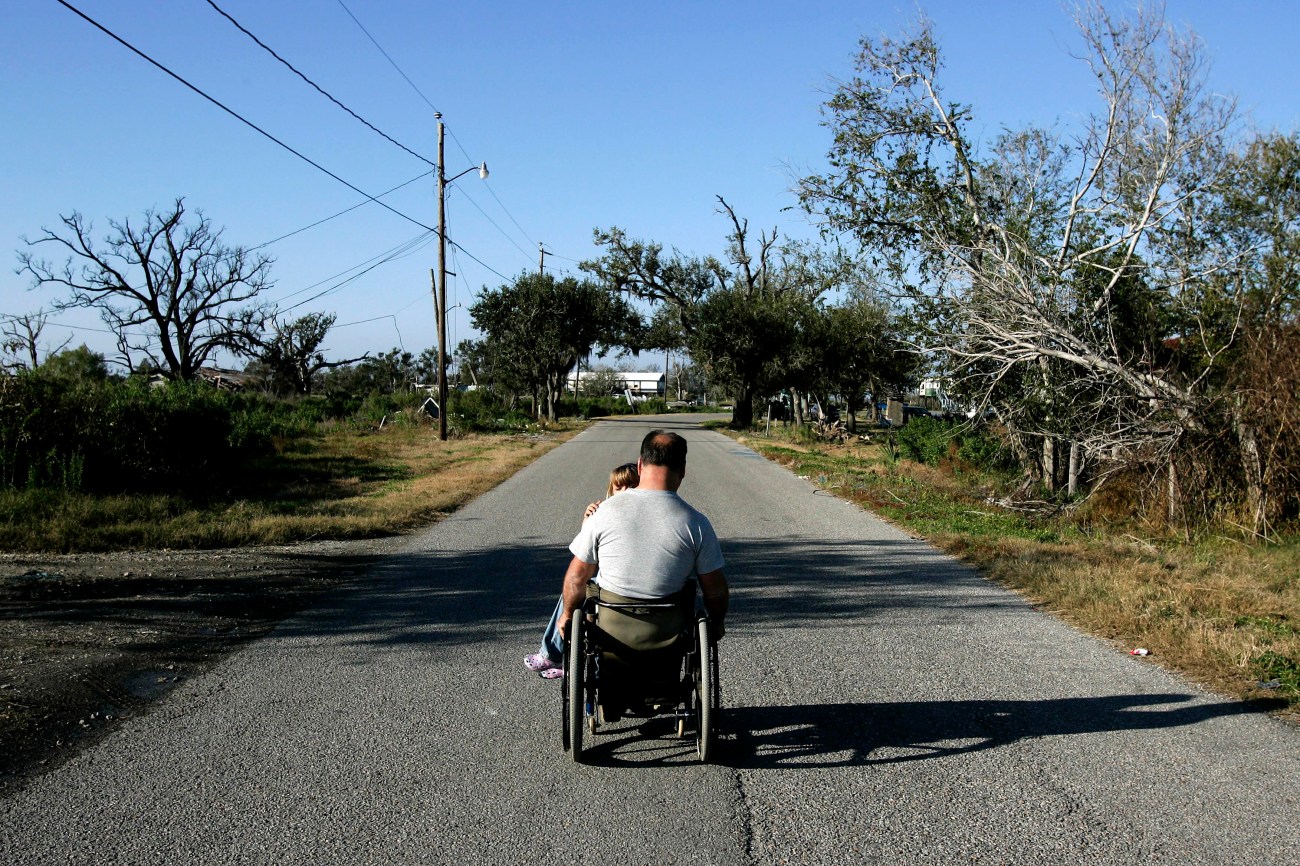
This Nov. 23, 2009 photo shows Chris Brunet carrying his niece Juliette, 6, in his wheelchair on Island Road, the only road on Isle de Jean Charles, La.
Patrick Semansky/ AP
In 2010, the Jean Charles tribe asked the Lowlander Center, a local nonprofit group, to help them in their resettlement efforts. Lowlander, founded by sociologists and disaster experts Shirley Laska and Kristina Peterson, helps lowland communities of coastal and inland Louisiana adapt to climate change and recover from environmental disasters. Peterson met the tribe’s chief in 1992 during the Hurricane Andrew recovery, and they’d stayed in touch.
Laska’s work as a professor emerita of sociology at the University of New Orleans and the founding director of the university’s Center for Hazards Assessment, Response and Technology opened doors. Peterson was a senior research fellow at that center before both of them left and founded the Lowlander Center in 2010.
Naquin hoped they could help the tribe raise money for land. For several years, Lowlander and the tribe worked on a blueprint for resettlement. The idea was to find a place large enough for the dwindling number of people on the island and the hundreds driven off it. There would be a tribal community center. A clinic. Pow wow grounds, traditional gardens, a market.
And then came word of HUD’s National Disaster Resilience Competition.
The announcement in June 2014 from President Barack Obama invited state and local governments that experienced a federally declared major disaster in 2011, 2012, or 2013 to “compete for funds to help them rebuild and increase their resilience.” The effort promised nearly $1 billion in funding for innovative projects demonstrating solutions to increasing climate disasters.
HUD’s Tregoning considered the one-time competition—administered in partnership with the Rockefeller Foundation—an opportunity for her agency to overcome institutional inertia and begin to change a system of disaster recovery that no longer works. Instead of dispersing money only after disaster strikes and rebuilding exactly the way things were before as if the same problems won’t reoccur, the country needs a forward-thinking approach, she said.
“Yes, we’re gonna address the disaster that happened,” Tregoning said. “But how can we do it in a way that builds resilience to future disasters in a community?”
As soon as HUD released the competition rules in September 2014, the Louisiana Office of Community Development got to work.
The staff had no time to waste. HUD gave applicants 180 days to prepare their first submissions outlining factors such as “recovery needs, relevant risks and vulnerabilities (current and future).” Those who made it to the second round had half that time to develop project proposals and solicit public comments.
“Even a community that has already embarked on this work is likely to find the timeframe challenging,” HUD acknowledged in its notice. Stan Gimont, who oversaw the competition, said in a recent interview that the deadline was standard for HUD.
Former employees of the Louisiana Office of Community Development said they thought it was flat-out unreasonable. Staff rushed to find cutting-edge ideas as the clock ticked down.
The proposal for the Isle de Jean Charles resettlement occurred almost by accident.
On September 26, 2014, emails and interviews show, Forbes—the state agency’s executive director—ran into Lowlander’s Laska at an unrelated press event. The two had known each other for years, since another state agency Forbes previously worked at funded some of her research. Laska told Forbes that her team was working with the Jean Charles tribe on a plan to resettle them. Forbes, thinking of the HUD competition, invited Lowlander and Naquin to a meeting, documents show.
There, according to records, the parties agreed to work together to determine whether tribal relocation would be a viable proposal.
Over the next five months, the agency, tribe and nonprofit pulled in other partners to help them gather data and put together a grant application. Records and interviews show Lowlander was responsible for providing outreach and demographic data about the island to the agency.
Four current and former employees of the state’s Office of Community Development told Columbia Journalism Investigations and its partners that Lowlander officials had led them to believe that all full-time residents of the island were members of the Jean Charles tribe. At one point, deep into the process, the nonprofit provided a report about resettlement best practices that mentioned that the island “is made up almost entirely of Isle de Jean Charles Tribal members.” The line did not set off alarm bells, one of the state employees said, because the agency knew some “campers” ineligible for relocation lived there part-time.
In an interview, Peterson said Lowlander gave the state information about the tribe rather than the island as a whole because the grant was for the tribe to reunify.
“It was not a proposal that was put in for the geography of a space. It was for a tribe to reconnect all of its people,” she said. “When somebody starts arguing, ‘Well, you didn’t tell us that there was Sam or Gertrude or whoever else was living there,’ that becomes very irrelevant when it was for a tribe to reassemble itself.”
But tribal reunification wasn’t what the HUD competition aimed to do, one former HUD official told Columbia Journalism Investigations and its partners in an interview for this story.
State officials say they did not talk to residents on the island to check who was there because they relied on the information from Lowlander.
Years later, researchers brought on by the state to help with the resettlement would tell the Office of Community Development that it should have done its own homework. One of them, the anthropologist Oliver-Smith, said in an interview that state employees recognized the severity of the misstep, calling it the project’s “original sin.”
But in March 2015, before any of that was apparent, state officials submitted the first application. Three months later, Mathew Sanders, the Office of Community Development policy manager leading the effort, told the Lowlander team that Louisiana had made it to the next phase.
“The work begins,” Peterson responded in an email.
The state tasked Lowlander with spearheading the vision for the proposed resettlement, which the tribe expected would allow reunification of current and former island residents. Peterson and her colleagues brought together sociologists, disaster experts, architects, engineers, and funders to create a blueprint.
One of the resulting documents described “a pilot site for climate change relocation with tribal livelihoods enhanced by innovation, teaching and sharing activities while … cultural traditions are rekindled with the tribal members living in one community rather than scattered as they are today.” The document emphasized the importance of community participation in the process.
The team eagerly waited for HUD’s decision. It came on January 21, 2016: Louisiana finished fifth, receiving $92 million for Isle de Jean Charles and another project.
Four days later, the state Office of Community Development touted its grant as a victory for “this Native American community in critical need of locating [to] a safer home,” and “a resettlement model that is scalable, transferrable, and supportive of cultural and social networks.”
Thomas Dardar, then the chief of the United Houma Nation, found out about the award soon after, in passing, from his real estate agent. Dardar said he couldn’t accept that his tribal citizens living on the island would not be included in the relocation.
“Our Tribal Council, although excited to see some much-needed funds come towards the plight of Isle de Jean Charles, is shocked that we were never informed and brought to the table in the discussion as UHN citizens reside there as well,” he wrote in a letter to Louisiana’s governor, John Bel Edwards.
Sanders, the Office of Community Development staffer, shot off an email to Lowlander: “Anything you all can shed light on?”
Peterson acknowledged in her reply the United Houma Nation’s long-standing attempts to address climate impacts on the tribe. That, she said, was separate from the Jean Charles tribe’s efforts.
“There are other people who are not part of the Tribe that reside on the Island,” she wrote, adding that “some may choose to be part of the project that UHN is working on.”
Forbes, with the state agency, said in an interview with Columbia Journalism Investigations and its partners that he then called Lowlander’s Laska to demand an answer about the island demographics: “Why did you tell me this when it’s otherwise?”
Asked about that call by Columbia Journalism Investigations and its partners, Laska did not respond. But in an earlier email to the news organizations, she wrote that tribes define their own membership.
“These are sovereign nations,” Laska said in the email. “We (whites, white bureaucracies) want uniformity across tribes, uniformity across generations of a tribe. Nope. The requirements by the federal government to achieve federal recognition have wreaked havoc on tribes.”
What the state found when it then sent its own people to talk to residents on the island is that most identified with the Jean Charles tribe, but not all, and the dividing lines are fuzzy. That’s because the tribe seceded from the United Houma Nation decades earlier.
“Two residents didn’t know which tribe they were supposed to be in,” agency contractors wrote in a report. “During our interviews, residents did not bring up tribal distinctions and more often noted that everyone on the Island is related.”
But the situation upended plans for the resettlement and splintered the partnership between the state, Lowlander and the tribe.
“The project was not doomed,” said Dakota Fisher, a former planner for the state who worked on the effort, “but the project was doomed to be hard and imperfect for the rest of its life.”
Fifteen days after the United Houma Nation chief sent his letter, a fact sheet from the state alerted the two tribal chiefs to the project’s change in scope: The “state’s objective is the resettlement of all willing members of the Isle de Jean Charles community, irrespective of any familial, cultural or tribal affiliation.”
A series of tense meetings between state officials, the tribes, the nonprofit, and HUD officials who flew in from Washington, DC, took place in July 2016, records show. In a meeting with tribal chiefs, HUD representatives explained provisions of the Fair Housing Act and the necessity to comply with them, HUD’s Gimont said in an interview. He added that the project had to thread a “pretty fine needle” by resettling one tribe while not unduly limiting participation by other island residents. The state did not see a way to fully do both.
The day afterward, the Jean Charles chief sent a letter to President Obama arguing that, in effect, government officials were using the Fair Housing Act to discriminate against his non-federally recognized tribe.
“I am a supporter of the purpose…of the FHA,” Naquin wrote. “However, in this case, they do not pertain because we are trying to maintain and revive our tribal identity as written in the grant.”
For months he and Lowlander advocated to return to the original vision of tribal relocation, records and interviews show. But there was a wedge now between the state and its partners.
State officials brought in a new team of sociologists and anthropologists, as well as their own staff, for community outreach. In 2018, when Lowlander’s contract on the project ended, the nonprofit did not sign a renewal.
To involve residents in the resettlement process, state officials convened a steering committee of tribal and non-Indigenous residents and business owners in 2018. But the committee disbanded after only six meetings, according to progress reports, meeting notes and interviews. Committee members from both tribes as well as others with no tribal affiliation described recurring fights with no resolution. Lora Ann Chaisson, the new principal chief of the United Houma Nation, said the state stopped scheduling the meetings after members pressed for answers about financial aspects of the resettlement, such as property taxes and high insurance costs on the new site.
The state, for its part, said the committee served its purpose. In an email, Marvin McGraw, the Office of Community Development’s spokesperson, pointed out that the meetings “were established to guide and inform the Master Planning process, review materials, make recommendations and provide continued local, cultural and contextual insight to the process.”
In an interview, Forbes acknowledged the gaps in communication. But he stressed that the state has been transparent about the property taxes and insurance and said the agency is working on solutions to reduce costs.
Nathan Jessee with Princeton University’s High Meadows Environmental Institute researched the Jean Charles tribe’s resettlement and witnessed the unraveling of its plans for the project. He said that ignoring the authority of the Jean Charles tribal council and creating a committee of people in conflict with each other “was really about demobilizing a tribal leadership who were trying to gain support for their resettlement.”
Naquin sent numerous complaints to HUD officials, asking for an investigation and contending that the project violated the agency’s rules. The complaints went unanswered, he said.
HUD did not respond to requests for comment about the complaints. The agency has also not yet provided documents on the matter that Columbia Journalism Investigations and its partners requested in February.
As Naquin and other members of the tribal council fought for the project they’d envisioned, the state moved forward on the revised version it developed.
In May 2020, on 515 acres of land on higher ground, contractors got to work building the new homes.
Forbes’ perspective as the head of the state agency overseeing the effort is that his staff went down the only path available to them. The project is a success, by his accounting, because Louisiana is moving people out of a dangerous situation.
Naquin’s perspective as the Jean Charles chief is that the project is yet another disaster for the tribe. Though he’s happy for the people getting new homes, the end result locked hundreds of members out. Tribal leaders had little say in developing the final plan, he said. And Naquin fears that an actual reunification is now impossible, even as he tries to secure new money for that goal, and eyes a site near The New Isle.
At the heart of the frustration and conflict is that the HUD grant wasn’t designed for what the tribe was trying to do.
“I think one of the tragedies of the Isle de Jean Charles relocation process is that the community had such a creative vision for the future,” said Siders, the University of Delaware disaster researcher. “You look at that initial proposal, and then see all of the ways that well-meaning, well-intentioned rules, laws, budget constraints, etc., got in the way.”
HUD hoped to learn lessons from Isle de Jean Charles. Multiple residents, government employees, and researchers said in interviews that this is the critical one: For resettlement to work at a large scale, the country must approach it differently.
“You have to have flexibility, you have to have room for the community to do things that deviate from the norm in order to deal with whatever that local context is,” Siders said.
Both officials and residents must go into resettlement with the understanding that it’s difficult, she and others said. Some degree of chaos and conflict is normal, and it takes a long time to gauge its success. But it will be less contentious if the agency overseeing efforts empowers and works with communities rather than dictates to them.
Focusing on communities’ right to self-determination is the key to better relocations, said Alaska-based human rights lawyer Robin Bronen.
Despite the Isle de Jean Charles challenges, HUD is well-equipped to lead such efforts, the Coastal Flood Resilience Project, an association of nonprofit groups, argues in a recent paper on community resettlement. HUD is focused on “comprehensive communities as opposed to just moving people out of disasters,” said one of the paper’s authors, Jeff Peterson, a former Environmental Protection Agency official and member of the White House Council on Environmental Quality during the Obama administration.
At the New Isle, two rows of houses—37 total—curve like a giant centipede next to an artificial pond. Only those still living on the island in August 2012 qualify. Twenty-five empty lots are prepped for eligible residents who left the island before then; they will have to pay for the home construction themselves.
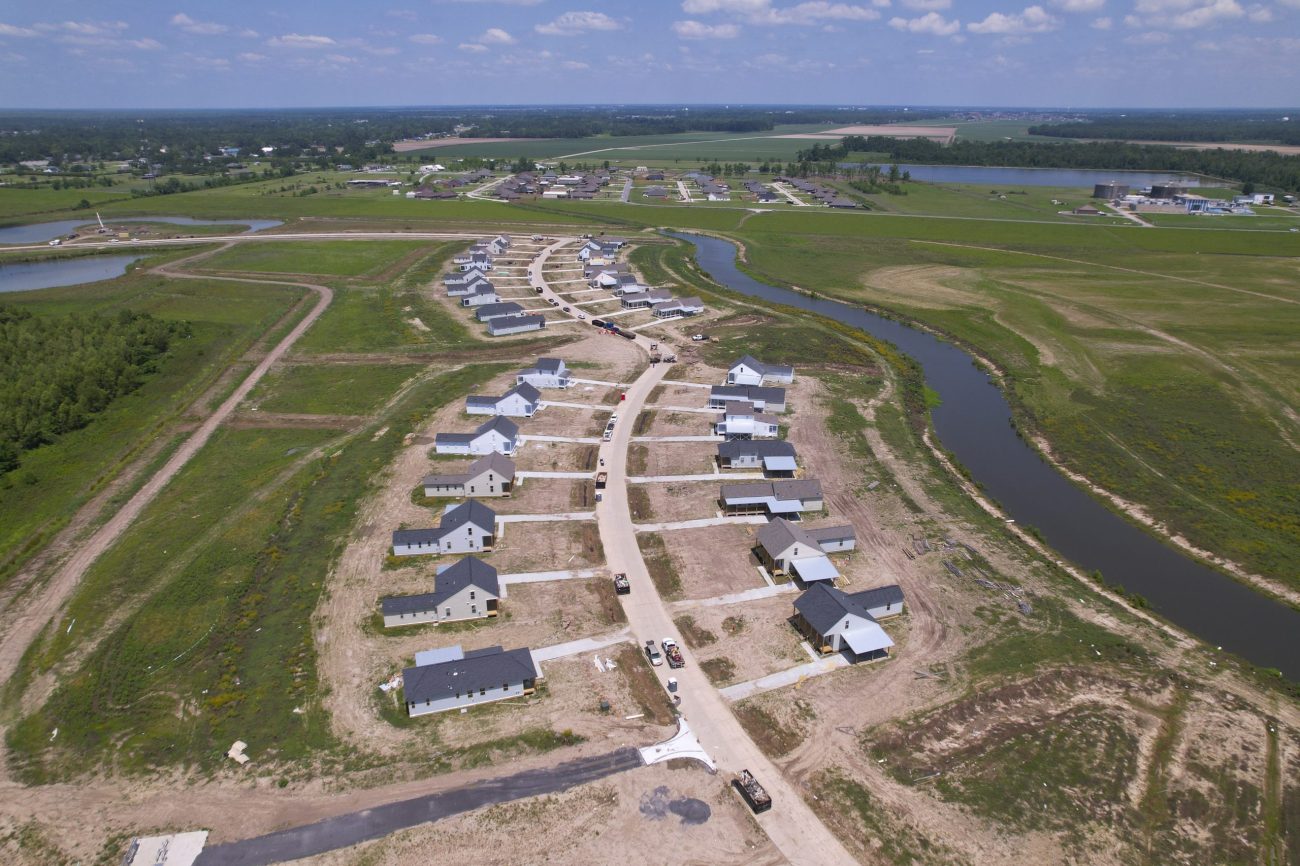
Homes at the New Isle are almost ready for residents in May 2022.
Olga Loginova / Columbia Journalism Investigations
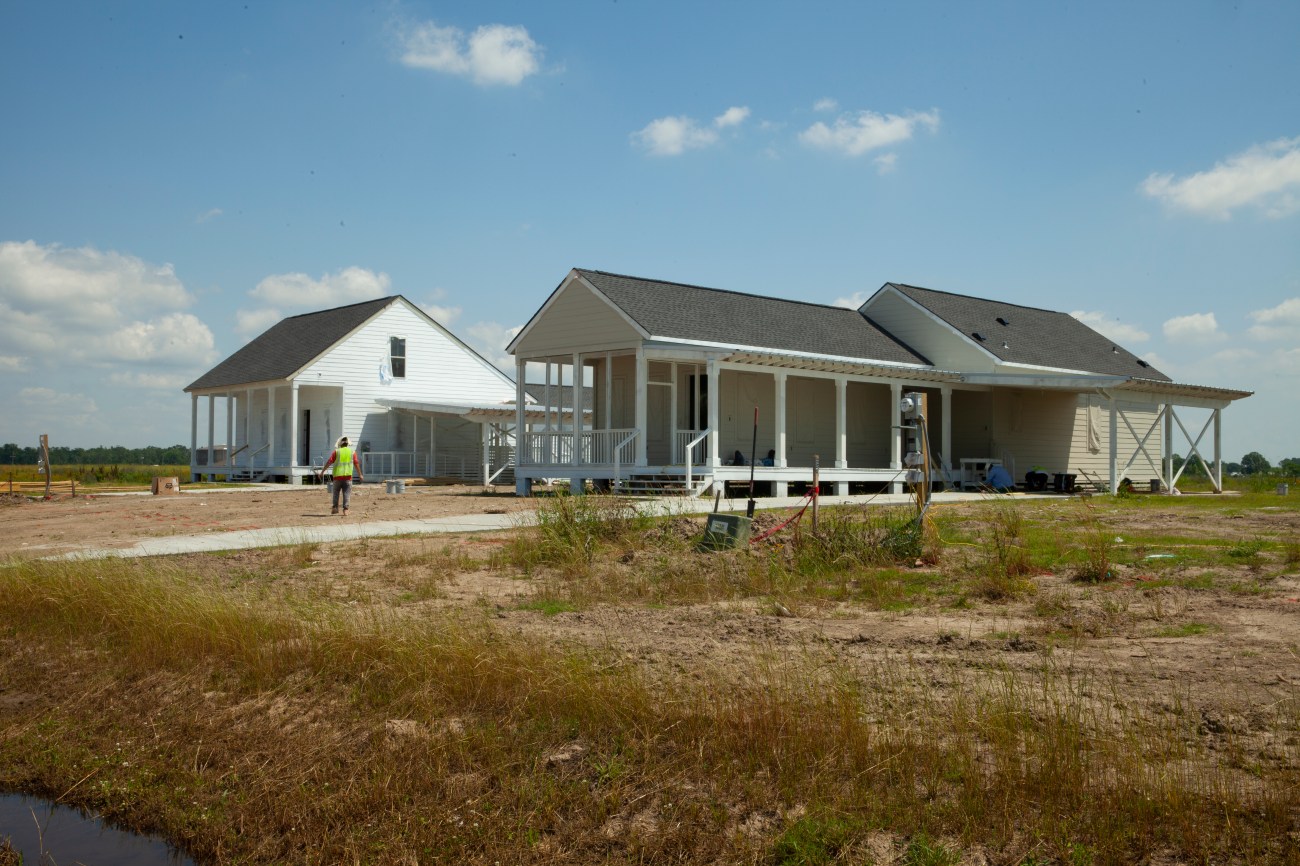
Houses close to completion on The New Isle in May 2022.
Olga Loginova / Columbia Journalism Investigations
Around a third of the new site sits inside a floodplain. The New Isle is still among the highest spots in the flood-prone Terrebonne Parish.
When Columbia Journalism Investigations visited in May, construction workers were finishing the facades. The subdivision looked nearly ready for a ribbon-cutting ceremony as if years of tension and disappointment never happened.
For the last two years, the Rev. Roch Naquin, the chief’s uncle, has lived in the administrative building on the premises of the church in Montegut where he preaches. He turns 90 in September and hopes to celebrate on The New Isle surrounded by family. More than once, during tense discussions about the resettlement, he would repeat: “While you have the opportunity [to resettle], you should take advantage of it.”
Brunet, his nephew, is moving next door to him. What’s unfolding isn’t the chief’s vision, but Brunet is sure no one would have received help without Chief Naquin’s efforts.
“I know HUD…gave the $48 million for the relocation. But it is not HUD who was talking about the relocation,” Brunet said. “They funded the relocation, but it’s not them that was advocating it. It was Chief Albert. It’s not the state that was advocating relocation. It was Chief Albert. And it wasn’t the parish that was pushing it…It was Chief Albert.”
That day in May, Brunet sat on the deck of his hurricane-damaged island home, sorting through debris. Salvageable possessions went into bins. The rest he trashed. Wooden boards driven by hurricane winds into his house stuck out at odd angles, like the remains of a ship wrecked by a storm.
All his memories and connections are tied to this land that saltwater is overtaking. He thought of the people who left. The 15 trees that were once in his yard—oaks, hackberries, persimmons, oranges, and pecans, all dead because of the incursion. The garden plots and chickens he and others here used to keep, gone now, too.
With the elevator not working and part of his home destroyed, Brunet was sleeping in a trailer, waiting for the move-out.
“Is there justice in me going over there? Is preservation the key point of why we’re going over there?” Brunet pondered this. “I have to sit here and say, yes, that’s why Chief Albert was pushing relocation, so that the community…remained as a community, as a people. So OK, that’s the preservation part of it. Now, what’s the justice part?”
CJI research assistants Gabriela Alcalde and Samantha McCabe contributed to this story.
Olga Loginova and Zak Cassel are reporting fellows for Columbia Journalism Investigations, an investigative reporting unit at the Columbia Journalism School. The Center for Public Integrity and Type Investigations, two nonprofit investigative newsrooms, provided reporting, editing, fact checking and other support. Additional funding for this story was provided by the Fund for Investigative Journalism.
Clarification: This story has been updated to clarify Nathan Jessee’s role at Princeton University and the federal government taking notice of the island’s demographics in the 19th century.
